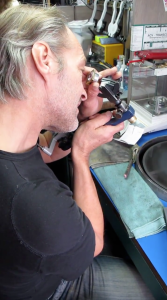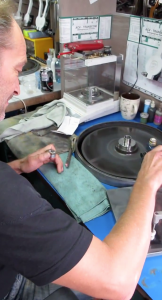
So it’s time to take the plunge and buy that engagement ring! As one of the most important purchases of your life, we thought we’d help out by providing you with “what you need to know” before you head to the jewelry counter: specifically, the four “C”s.
This month we’re starting with the first “C”: Cut. And we’ve included a couple photos from our recent trip to Antwerp of diamond-cutting in action!
While many might believe that cut refers to the shape of the stone (pear, oval, round), it actually refers to the symmetry, proportioning and polish of a diamond.
The cut of a diamond is one of the most important factors differentiating one diamond from the next. The way a diamond is cut has the greatest influence on its ultimate beauty and “bling”.
Unlike other stones, diamonds have a unique ability to manipulate light. This quality can only be realized with an extremely high level of accuracy during the cutting and polishing process. Where nature determines a diamond’s distinctive color and clarity, nurturing by a skilled cutter determines the quality of the cut.
The art of diamond cutting can be traced back to the mid 1300s, when gem cutters in both Europe and India first began to shape and cut the rough stones. The process is not an easy one to master.

While cutting a diamond in the rough, one must not only consider the proportions of the diamond in question, but also the workmanship of overall symmetry and polish. The brilliance of a diamond is caused when light enters the crown and reflects from one facet to another, then returns out the top or “table”. A diamond that is cut too shallow or too deep will not reflect light properly, and the diamond won’t be as brilliant as a diamond with an excellent cut.
The most popular diamond cut is the modern round brilliant, where the facet arrangements and proportions have been perfected both by mathematical and empirical analysis. Also popular are the fancy cuts, which come in a variety of shapes—many of which are derivatives of the round brilliant.
A diamond’s cut is evaluated through trained inspection, with higher marks given to the stones that have symmetry and proportions most closely matched to the particular “ideal” used as a benchmark, which often varies by region. At Stones Jewelry, our diamonds are rated using the G.I.A.’s rating scale.
Keep an eye out for next month’s “C” as we continue the series with “Clarity”. And, in the meantime, if you have any diamond questions we can answer right away, don’t hesitate to stop in. We have a gorgeous collection of diamond rings, earrings, pendants and broaches we’d be happy to explore with you.








Stones News & Announcements » Blog Archive Stones Jewelry Discusses a Diamond’s Four C’s: Color Says :
[…] month’s installment is all about color. If you’re just tuning in, you can catch yourself up on Cut and Clarity by following the included […]